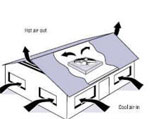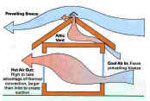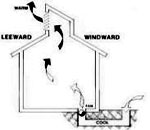 |
|
Energy Efficient House Cooling Techniques
Description:
Cooling of houses is an important topic for countries like Malaysia where temperatures are high year-round. Instead of using the power-hungry air-conditioning system, there are many other environmentally friendly techniques that can help cool a house. Many of these techniques can be applied to the structure of the house. This activity will encourage students to experiment with some.
Students will be challenged to think about properties of a house that affects the temperature inside. This can mean how to prevent heat from outside, remove heat to the outside, retain cold air inside, or other variants.
Students will pick one or more aspects from the above to investigate. They will then spend time building a house model using a mix of pre-fabricated parts (to reduce the time required) and custom cut pieces. They will then test its performance. This test would involve using the gogoboard to monitor inside-outside temperatures. The activity will conclude with a short presentation and discussion by the students.
Materials
Description GoGoboard temperature sensors Computers hand held electric mini-drill Card board boxes with lid dry-ice means to create some smoke large transparent bottles with a lid projector Household alcohol Insulated container (to store the dry-ice and use for demo) nuts and bolts Corner Braces Black/White water paint small hinges glue, epoxy glue rulers knife cutter scissors table top fan
Procedures
Mini Workshop (2 or 3 hours)
- Overview of project and the tools (30-40 min)
- A demonstration of some basic concepts involved in climate control systems. For example:
- Air flow - show how hot air is lighter than cold air. Have two clear bottles one containing smoke and another containing dry ice. When the bottle is opened smoke will flow upwards while the colder CO2 gas from dry ice will flow downward (will need to pour some water onto the dry ice to make it happen.)
A fan can be used to demonstrate the role of wind and how to channel air through the house.
- Evaporation - Students can try rubbing household alcohol on their skin to create a cooling sensation.
- Insulation - Demonstrate how an insulated container can prolong the inner temperature (both hot and cold.)
- A slide show of various house designs that has some of the above features. The goal is to contextualize the presented concepts.
- Do a gogoboard demonstration showing how it can be used to sense change in temperature.
- Describe the hands-on activity and the available materials.
- Hands-on project time (60 or 120 minutes)
- Divide students into groups and pick a topic to explore.
- Each group should perhaps have a facilitator to help speed up the process.
- Results can be measured in various ways. I.e.
- Using the gogoboard to measure temperature change over time
- Use dry-ice or smoke (small amounts) to observe air-flow
- Presentation (20 min)
Short experiments (30 min)
- Do the same as the mini workshop but abbreviate the overview
- Allow students to spend time with house models built by other students who participated in the mini workshop.
- This implies that we need to conduct the mini workshop at least once before to have these materials.
- Students can do quick tests using dry-ice, smoke, and perhaps the gogoboard.
Setup
- It is best if we have a dedicated area or room for this activity.
- The setup would be similar to a normal SEED workshop where there are tables dedicated to programming, crafts, electronics. There should also be enough opens space for presentation and discussion with a projection screen.
- Being able to go outside would be important as many models would need to be tested in the sun.
- For the longer version, since time is very limited, the basic house structures will need to be pre-fabricated (i.e. a storing box with a lid.) Students can then decide on how to modify the structure to include cooling features like vents, attics, windows, fans, a clay roof, white or black outer paint color, etc. House construction must be limited to 30 minutes.


